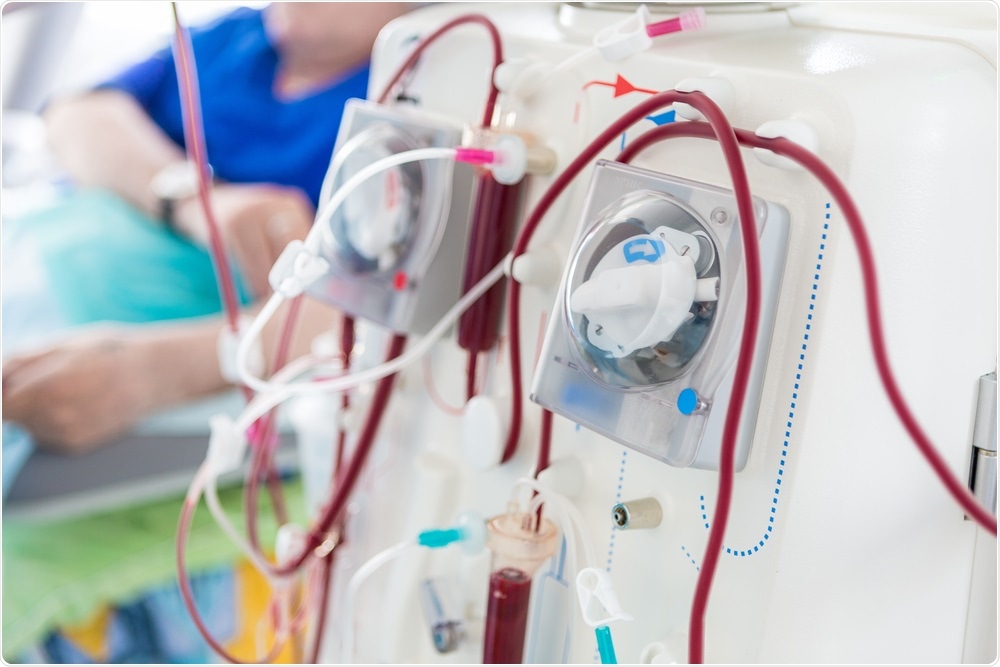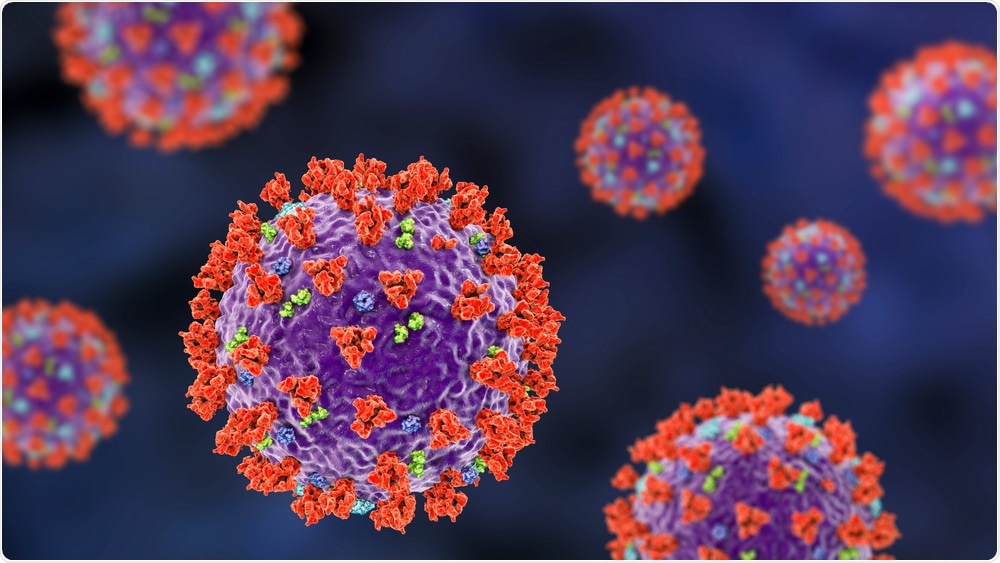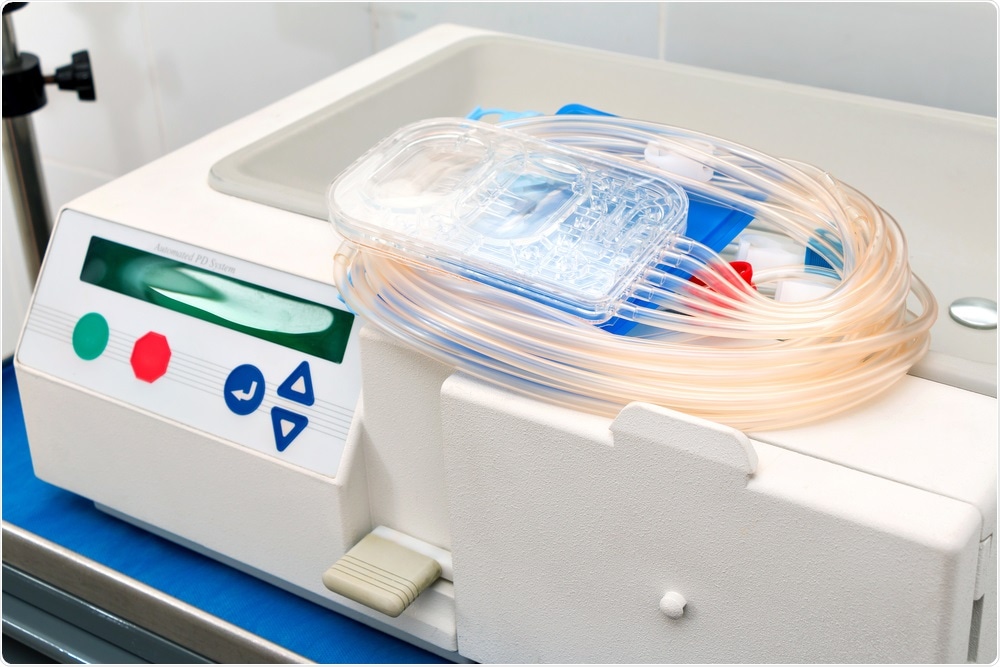In this interview, News-Medical speaks to Professor Simon Davies and Professor Raymond Vanholder about the impact of COVID-19 on kidney dialysis patients.
Please could you introduce yourself and tell us about your expertise within kidney disease and dialysis?
Simon:
I have been working in the field of kidney disease and dialysis for 35 years and I am currently a Professor of Nephrology and Dialysis Medicine and Keele University, UK, and a consultant Nephrologist based at the University Hospital of North Midlands (Stoke on Trent).
I have particular expertise in peritoneal dialysis – the main form of dialysis done in the patient’s home – and my research has ranged from experimental translation work (e.g. on how the peritoneal membrane works and is affected by the dialysis process) to more generally how best to use dialysis to control the amount of fluid in the body, and more recently on the factors leading to the discrepancy in the use of home dialysis – both in the UK and internationally.
I am currently chief investigator of the National Institute of Health Research (NIHR) funded Inter-CEPt study (£1m) designed to understand why there are discrepancies in the use of home therapies in the UK to create interventions that will reduce this. This is multidisciplinary research involving co-investigators at Keele, Birmingham, and Sheffield Universities.
Raymond:
I am a nephrologist and general internist for more than 30 years. I have been mostly involved in research on clinical nephrology, dialysis, dialysis adequacy, biochemistry of uremia, and acute kidney injury. I was head of the Nephrology Section of the Department of Internal Medicine and Pediatrics of Ghent University Hospital in Belgium until my retirement in 2014, and am a past president of the Belgian Society of Nephrology (BVN), the European Society for Artificial Organs (ESAO) and the European Renal Association (ERA – previously ERA-EDTA).
Since my retirement, I am president of the European Kidney Health Alliance (EKHA), a Brussels-based NGO defending the case of kidney patients and the nephrological community at the level of the European Union (EU) and the national level. I also chair European Chronic Disease Alliance, another NGO and umbrella organization bringing together 12 European Chronic Disease Societies. Apart from writing scientific opinion papers, my activities currently focus on advocacy for kidney diseases and chronic diseases at the European level.

Kidney Disease. Image Credit: crystal light/Shutterstock.com
Globally, 1 in 10 people have been diagnosed with chronic kidney disease and the number of people with advanced kidney disease is rising, but there are still over 2.5 million people that do not have access to lifesaving treatments. Why is this, and what can be done to help ensure everyone has equal access to lifesaving treatments such as dialysis?
Simon:
Dialysis is an expensive treatment. There is no country in the world in which there is equitable access to dialysis that does this without including dialysis within a universal healthcare coverage system – and many countries do not have this. Even if they have universal healthcare, they may not include dialysis within this, preferring to spend their money on interventions that are more cost-effective – in particular the prevention of progression to dialysis. Some of these treatments work well and are very cost-effective.
However, many people still need dialysis treatment. In countries without universal healthcare then only those who can afford it will have dialysis – and sadly many families run out of money – so-called catastrophic healthcare expenditure: the money runs out, the patient dies, the family is bankrupt – the term ‘dialysis is an expensive funeral’ has been used.
So, to ensure equal access to this life-saving treatment, the most important thing is a comprehensive healthcare coverage system that is set up to provide dialysis. There are ways of doing this – e.g. a government scheme to provide dialysis as cost-effectively as possible (and some countries have elected to do this with home peritoneal dialysis – so-called PD first policy – e.g. Hong Kong, Thailand), others develop public-private partnerships with dialysis provision companies, others rely on a mixed model of health insurance schemes – often based around the individual's employer scheme (e.g. mainland China).
Raymond:
For a large number of people and countries, dialysis is too expensive and it is also difficult for several of them to properly organize kidney replacement therapy for as many people as possible. In addition, many countries do not offer (or insufficiently offer) the optimal option of kidney transplantation, not enabling them to become independent of dialysis one day.
The consequence is that many patients with chronic kidney disease in lower-income countries do not get dialysis, or die on dialysis, quite often after a few weeks or months, when they and their family run out of financial resources. Even in Europe and the US, where dialysis is reimbursed for all or most patients, certain social groups (migrants, refugees) are probably missing treatment, and many more miss the most appropriate treatment option. The best way to circumvent these problems is to avoid for as many as possible that they develop kidney disease or the diseases causing them (e.g. diabetes, hypertension) by primary prevention via healthy lifestyle, or, if kidney disease nevertheless develops, to stop or refrain progression to dialysis by secondary prevention.
Prevention is underexploited worldwide. For those still in need of dialysis, to ensure optimal access, cheaper and simpler dialysis options are needed, whereas financial pressure can further be alleviated by properly organizing transplantation programs.
Peritoneal dialysis would be an ideal solution, were it not that in many low income and middle-income countries, no local production of peritoneal dialysis fluids exists, so that they have to import those fluids which increases cost due to import taxes and long-distance transport. Hence, local production of peritoneal dialysis fluids would be another solution.
What is dialysis and what dialysis methods are currently available for patients?
Simon:
Dialysis is a treatment for kidney failure designed to replace some of the functions of the kidney. The most important of these is the removal of toxins (that accumulate from metabolism) and the fluid that we drink.
There are two main ways of doing this, hemodialysis – which is extra-corporeal, i.e. a dialysis machine takes the blood of the patient out of the body, passes it through a filter and returns it minus some toxins and with less water, and peritoneal dialysis, which is intra-corporeal – i.e. it uses the patient’s own peritoneal membrane (which is the lining of the abdominal cavity) as the dialysis membrane – by placing a couple of liters of dialysis fluid in the abdomen – and exchanging this fluid every few hours once it has equilibrated with the blood.
Raymond:
When the kidneys fail too much, metabolites that normally are excreted by the kidneys, accumulate in the body. These intoxicate the body causing complications, e.g. accelerated cardiovascular disease, resulting in premature death, unless these metabolites are removed. Dialysis is a way to accomplish this removal. Metabolites are removed through a membrane through which those metabolites shift from the blood to pure water that flows at the other side of the membrane.
In the case of hemodialysis, the membrane is a manufactured chemical structure and the water is mechanically pumped through the system; in the case of peritoneal dialysis (PD), the membrane is natural, i.e. the patient’s own peritoneum, and the water is instilled in the abdomen either manually or by a machine. With advanced kidney failure, patients also tend to accumulate fluid that should be removed. This occurs for hemodialysis by regulating pressures within the system forcing extra fluid through the membrane or for PD by adding osmotic agents to the dialysis fluid that cause plasma water to shift from the bloodstream to the dialysis fluid.
Peritoneal dialysis usually is performed at home; hemodialysis can be performed remotely from home in a center, either linked to a hospital or not, or at home. Worldwide, the large majority of dialyses currently occur in-center.

Dialysis. Image Credit: Aleksander Ivansenko/Shutterstock.com
Can you give an overview of some of the advantages and disadvantages of the two home dialysis options available (peritoneal dialysis and home hemodialysis)?
Simon:
The main difference is complexity – PD is a simple method, which can be taught in a few days and does not rely on external machinery – including electricity in its simplest form. Home HD is inherently more tricky to do, requires the patient to learn how to place needles into a fistula (a surgically fashioned adaptation typically to a vein in the forearm which can supply the blood for the extracorporeal filter) and this takes longer to train. The house must have a good clean water supply as large volumes are needed.
The disadvantage of PD is that dialysis fluid has to be commercially prepared (must be sterile) and shipped to the patient’s home in bags – and in many countries, this is unreliable and too expensive (especially if imported and taxed by the government). There are also differences in longevity of outcome – PD is good for a few years (which for many patients is OK because survival on dialysis for many will not be so long – 40% survive 5 years, or, if available they will get a kidney transplant, which is much superior to dialysis as a treatment for kidney failure), but for a significant proportion, in the long run, home HD will be better for survival and well-being.
It is important to understand that many kidney failure patients – especially those who live longer – will use more than one treatment over a lifetime. Finally – but very importantly – patients have preferences – they want the dialysis treatment that fits in best with their personal lifestyle if that choice is open to them. Patients who want dialysis at home usually prefer this because it increases their flexibility.
Raymond:
Both home hemodialysis and peritoneal dialysis offer more advantages than disadvantages. The greatest advantage is certainly that by their performance at home, no transport of the patient to a dialysis center is needed and that the dangers created by the hospital milieu, especially infections, are obviated. Specifically for home hemodialysis, the timeframe can more easily be adapted to the patient’s needs (e.g. nocturnal dialysis, daily dialysis, longer dialysis sessions) which forestall complications such as hypotension and the ensuing end-organ oxygen need (e.g. of the heart and brain).
PD is by definition more protracted or continuous with minimum risks of volume shifts leading to hypotension. In addition, the remaining function of the own kidneys is often preserved longer. Both home hemodialysis and PD generate in most high-income and middle-income countries a lower health care cost for reimbursement than in-center hemodialysis. This relationship is only inverted for lower-income countries for the reasons mentioned above (drawbacks due to import).
The main disadvantages of peritoneal dialysis are the risk to develop infection of the peritoneal cavity (peritonitis) and with time quality loss of the peritoneal membrane so that it is often necessary after some time to discontinue the treatment and to shift to hemodialysis. Patients are also sometimes moderately fluid overloaded. Also, hemodialysis carries a specific infectious risk, i.e. of the vascular access system through which the dialysis machine is connected to the patient, which then directly can evolve to bloodstream infection (sepsis).
In addition, since hemodialysis is performed over shorter periods which makes them brisker, this leads to more hypotension. The plastic material of the dialysis membrane and circuit can elicit undesired reactions (bioincompatibility) and leach into the patient’s bloodstream. However, all these disadvantages are the same for in-center hemodialysis. Both peritoneal dialysis and hemodialysis remove metabolites insufficiently compared to healthy kidneys, which results in accelerated death, especially from cardiovascular and infectious problems.
Both methods are also imposing an ecologic problem by either substantial water consumption, plastic waste generation, considerable energy consumption, and CO2 production, or a combination of these (but also these problems are the same for in-center and home dialysis).
It will never be possible to treat all dialysis patients at home. In-center hemodialysis may be needed in at least some people for medical reasons, home hemodialysis training, the patient’s own will, or temporarily because of hospitalization.
How has the ongoing COVID-19 pandemic impacted dialysis patients? Why is there now a greater need to increase access to home dialysis?
Simon:
Sadly, dialysis patients have suffered greatly during the pandemic. Early on this was because of the relative ease of catching COVID while traveling up to center-based dialysis units and these patients have had significantly more infections than those treated at home.
All dialysis patients are at increased risk of death once they get COVID-19, partly because they are often older and also because they have multiple comorbid conditions – e.g. diabetes – which makes then much higher risk – the proportion of deaths in those center-based HD patients in the UK who contracted COVID was around 25%. Thankfully the risk of catching it has much reduced following the vaccination program and better infection-prevention procedures at the dialysis units. How effective the vaccines are in dialysis patients is yet to be determined.
Raymond:
Of all comorbidities, chronic kidney disease (either not on kidney replacement, on dialysis, or transplanted) had among the highest independent risks to be infected, and, apart from the very elderly, those with advanced chronic kidney disease had, once infected, the highest risk to die. One of the main reasons is that patients with chronic kidney disease have a defective immune defense. Most other chronic diseases also have an increased independent mortality risk vs. the general population (be it not as important as for chronic kidney disease).
As many patients with chronic kidney disease also suffer from other chronic diseases, either as a cause or a consequence, this further increases their risk. Among dialysis patients, those with home treatment had a manifestly lower risk than those treated in-center. The reason for this is that a dialysis center is a closed community so that if someone in that community (either patient or personnel) developed COVID-19, the disease was brought into the community with a high risk to spread (in a way that is similar to what was observed in many retirement homes).
COVID-19 has also taken up a huge amount of resources over the last year with many healthcare professionals working together to develop effective treatment strategies. How could this level of collaboration be used to boost access to home dialysis?
Simon:
The use of home therapies does differ quite a bit between dialysis centers in the UK – and also between countries. In some countries, they are hardly used at all.
The reasons for this are multiple but include lack of awareness that they are available, paternalistic healthcare systems in which patients do not have sufficient say in their healthcare, lack of training of healthcare professionals, financial remuneration of healthcare professionals that does not adequately support home dialysis and lack of availability of affordable PD fluid. This is an opportunity to improve access to home therapies and make this more equitable.
Raymond:
The quality of life and survival of their patients is the first concern of all health care professionals. Taking into account existing evidence, they thus should make major efforts to enable a shift of paradigm away from the current situation towards home treatment for all valid candidates. The quick recent rise in the use of telecommunication tools can only facilitate this move.
The frequent work overload in nephrology and in-center hemodialysis units during the pandemic with drop-out of personnel due to disease or burn-out and loss of many patients due to fatalities could only facilitate this move, by creating awareness among those professionals that the current focus on in-center hemodialysis is far from optimal.
The pandemic also has made kidney patients more aware of the need to stand up for their rights and their wishes, which can only accelerate the shift of paradigm. Finally, the pandemic also forced health professionals to abandon thinking and acting in silos, which again favors changes of practice.

COVID-19. Image Credit: Kateryna Kon/Shutterstock.com
Why is it important to raise awareness around dialysis and the different options available for patients?
Simon:
Dialysis is not a single one-off treatment – like a surgical procedure to make you better. It is a treatment that the patient and their family/carers have to live with. It affects every corner of their lives and having different options of how to do the dialysis makes it a little easier for the patient to fit the dialysis around their lives and not the other way around.
We want people with kidney failure to be in charge of the treatment they get.
Raymond:
The final choice of treatment should be made by the patients (if useful together with their next of kin) with a maximum of appropriate information. Nowadays the patients are too often directed by medical professionals in a paternalistic way. Information delivery is often perceived by the patients as insufficient, which is especially the case if a certain option is not frequently applied or not available in a certain hospital or region (e.g. home hemodialysis). Especially the barrier between doctors and the patients is often perceived as too high and such information is often more adequately delivered by nurses.
Specific training in information delivery is very useful and should be given to students as well as qualified professionals and all involved professionals, thus not only physicians but also any other professional involved in the provision of information, such as psychologists, nurses, social workers, pharmacists, etc. (students as well as qualified professionals). Involvement of patients can be extremely helpful as well as home visits by teams that have been specifically created for this purpose (Tupperware style).
Information delivery is especially difficult towards minorities, people with low income, and the health illiterate, which are more difficult to reach and for whom specific techniques should be considered and developed, preferentially in cooperation with those communities. Benchmarking strategies could help to assess the completeness of information delivery and patient satisfaction.
What more needs to be done to help improve the quality of life for patients requiring dialysis?
Simon:
It is not all about the dialysis itself – there are many symptoms that dialysis patients experience which the dialysis does not help with – so more research and treatments for these are important. Also, we could make the dialysis treatment itself easier and better, with better equipment that is easier to use, more portable and less intrusive, and easier to adapt to the specific requirements for an individual.
Also, it turns out that even when the kidneys have failed and dialysis is needed, that having a tiny amount of preserved kidney function (as little as 1%) gives great benefits – including survival – so ways of doing dialysis that maintain this very small amount of function for as long as possible need to be better understood.
Raymond:
The further development of telecommunication strategies should facilitate treatment at home, where it belongs. Simplification of dialysis machines and hardware should be of further help. Portable and even wearable dialysis machines should allow more flexibility with regards to timing and place of treatment. Miniaturization is a global technological trend that did not yet find its way into the dialysis environment.
The development of innovative strategies for the prevention of the progression of kidney disease should be promoted. There is a lack of innovation in this therapeutic area as compared to other chronic disease therapies. Finally, more attention should be paid to improve patient-centered outcomes (i.e. complaints that affect patient quality of life despite little impact on survival, e.g. itching, cognitive dysfunction, or fatigue).
We have insufficient knowledge of the causes and mechanisms, and therapies specifically developed for chronic kidney disease patients are scarce to non-existent. Strategic changes, as well as research, should be developed in collaboration and dialogue with patients.
Are you hopeful that with increased collaboration and patient engagement, one day everyone will have access to life-saving dialysis treatments?
Simon:
Yes – but it will take some years, and COVID will have set this back – for example, India has been trying to develop a system of government insurance to support dialysis, but this plan will undoubtedly be delayed.
Raymond:
Yes and no. Reaching this goal on a worldwide basis will probably not be possible in the next decades but it may be possible in regions that have already a reasonable healthcare basis. Yet, it remains a multifaceted problem that needs multifaceted solutions, depending on economic progression, socio-economic responsiveness, readiness to eliminate inequalities and for cross-border collaboration, improvement of access to geographically remote areas, willingness to make decisions based on medical and health-economic evidence, technological progress, investment in research, presence of political champions and patient advocates and readiness for policy decision making to make all this happen.

Home Dialysis System. Image Credit: Henrik Dolle/Shutterstock.com
What are the next steps in your career into kidney disease and dialysis?
Simon:
My current research is focusing on understanding better the reasons why there is not more equitable access to home dialysis in the UK – they are complex – and developing approaches to reducing this – the above-mentioned Inter-CEPt study.
I also work with the International Society of Nephrology to develop their Kidney Failure Strategy – which we are now beginning to roll out. The ISN works closely with the WHO and we recently produced a guide for how to develop dialysis services in low resource settings and we are in the process of creating some educational materials to support this.
Raymond:
I retired six years ago, so my personal ambitions are limited and my wishes are rather for the nephrological community at large than for myself. Any further step forward is a bonus. I hope I remain healthy to continue for a few years, enough time to increase awareness of kidney disease outside the nephrological community in Europe and Worldwide.
The first steps in this direction have been made. I hope to see the day that kidney disease will figure among the key health care areas of the European Commission. We were able to talk with the EU Commissioner of health, Kyriakides, who assured us of her full support. The “Decade of the kidney” campaign (2020-2030) launched by the American Association of Kidney Patients (AAKP) is a very useful tool to reach these aims. The aim is an effort similar to that provided for cancer over the last 30 years.
Furthermore, I hope to still prepare a few publications that are of use to improve the fate of kidney patients and to direct kidney care into a more sustainable course. Finally, I would like to play a modest role in boosting European research by nephrologists on acute kidney injury, green nephrology, and sustainable therapeutic options.
Where can readers find more information?
- https://www.nhs.uk/conditions/dialysis/
- https://doi.org/10.1016/j.kint.2020.07.023
- VANHOLDER R., ANNEMANS L., BROWN E., GANSEVOORT R., GOUT-ZWART J.J., LAMEIRE N., MORTON R.L., OBERBAUER R., POSTMA M.J., TONELLI M., VAN BIESEN W., ZOCCALI C. Reducing the costs of chronic kidney disease while delivery quality health care: a call to action. Nat. Rev. Nephrol., 7, 393-409, 2017
- VAN DER TOL A., LAMEIRE N., MORTON R.L., VAN BIESEN W., VANHOLDER R. An international analysis of dialysis services reimbursement. Clin. J. Am. Soc. Nephrol., 14, 84-93, 2019
- DE JONG R., STEL V.S., RAHMEL A., MURPHY M., VANHOLDER R.C., MASSY Z.A., JAGER K.J. Patient-reported factors influencing the choice of their kidney replacement treatment modality. Nephrol. Dial. Transplant., in press, 2021. Doi: 10.1093/ndt/gfab059
- VANHOLDER R., ANNEMANS L., BELLO A.K., BIKBOV B., GALLEGO D., GANSEVOOT R.T., LAMEIRE N., LUYCKX V.A., NORUISIENE E., OOSTROM T., WANNER C., WIERINGA F. Fighting the unbearable lightness of neglecting kidney health: the decade of the kidney. Clin. Kidney J., in press, 2021 Doi: 10.1093/ckj/sfab070
About Professor Simon Davies
As a clinical academic, I have developed a career in researching the problems of dialysis. For many years the focus has been on peritoneal dialysis and this led me to being president of the International Society of Peritoneal Dialysis between 2020-12; my work for this organization was recognized by the award of the Distinguished International Medal by the American National Kidney Foundation in 2013.
Currently, I am president of EuroPD – an organization based in Europe with the mission of improving research and education for health care professionals in the field of home dialysis, in particular peritoneal dialysis. More recently I have chaired the International Society of Nephrology’s dialysis workgroup and been closely involved in the development of their Kidney Failure Strategy and their work with the WHO.
About Professor Raymond Vanholder
Dr. Vanholder published more than 900 papers, including reviews and book chapters, on the adequacy of dialysis, uremic toxicity, and various topics related to clinical nephrology, especially cardiovascular and infectious complications. He serves as a member of the editorial review board of several journals and is subject editor of Nephrology Dialysis and Transplantation and Toxins.
Up till autumn 2010, he has been chairman of the European Uremic Toxin Work Group (EUTox), and member of the Executive Board, and treasurer of Kidney Disease Improving Global Outcomes (KDIGO). Up till summer 2011, he was chairman of the European Renal Best Practice (ERBP). Up till autumn 2014, he chaired the Renal Disaster Relief Task Force (RDRTF) of the International Society of Nephrology (ISN) and participated in several international relief operations.
Dr. Vanholder was the founding president of the Belgian Society of Nephrology (BVN-SBN), is past president of the European Society of Artificial Organs (ESAO), and past president of ERA-EDTA. He is now retired (Prof Em at Ghent University) and president of the European Kidney Health Alliance and chair of the European Chronic Disease Alliance.